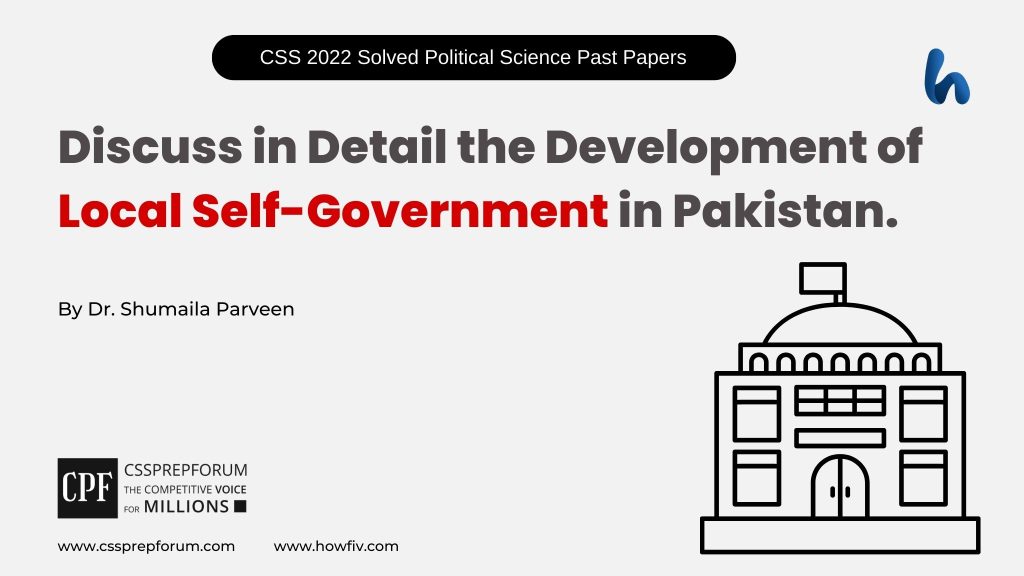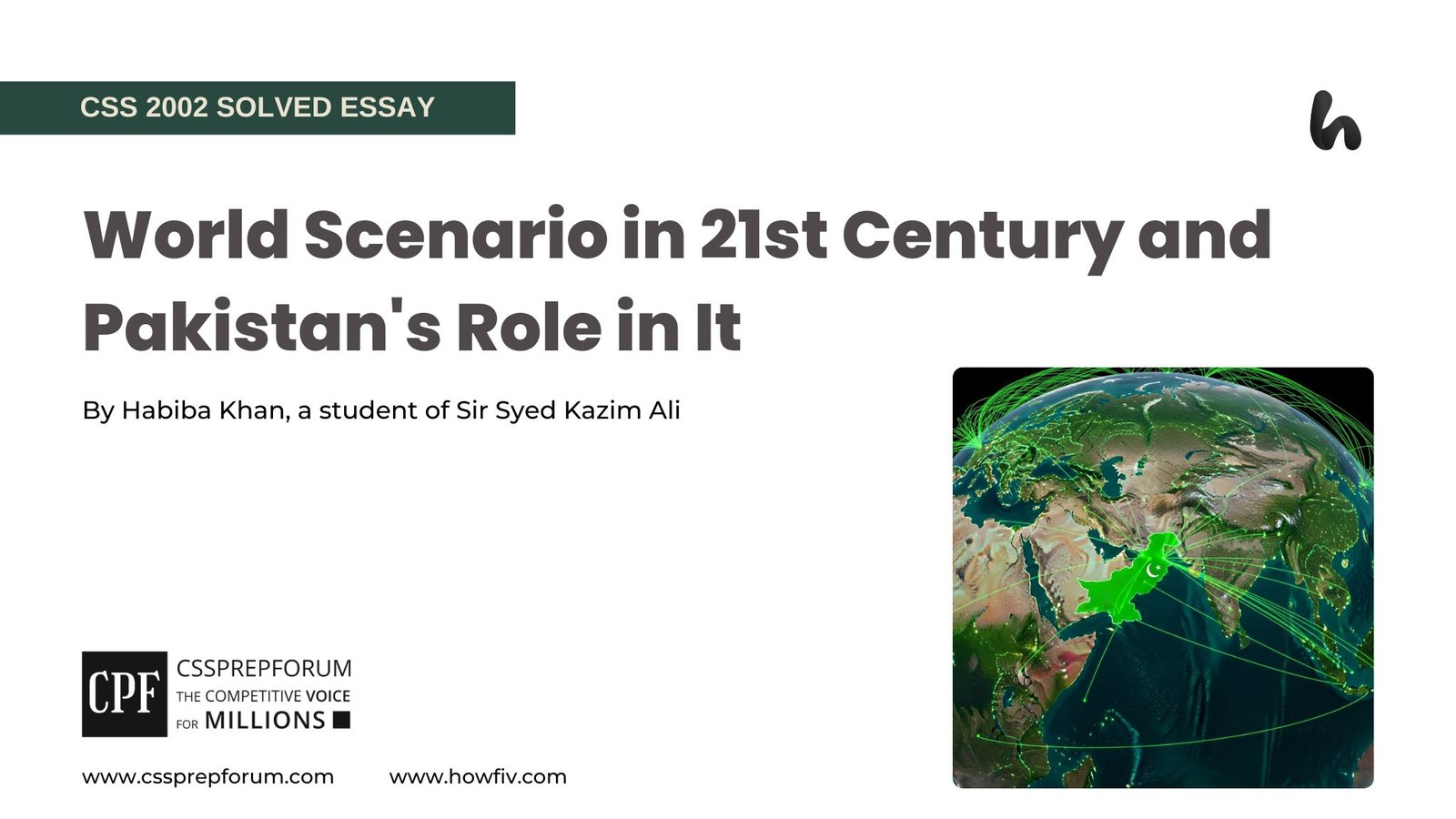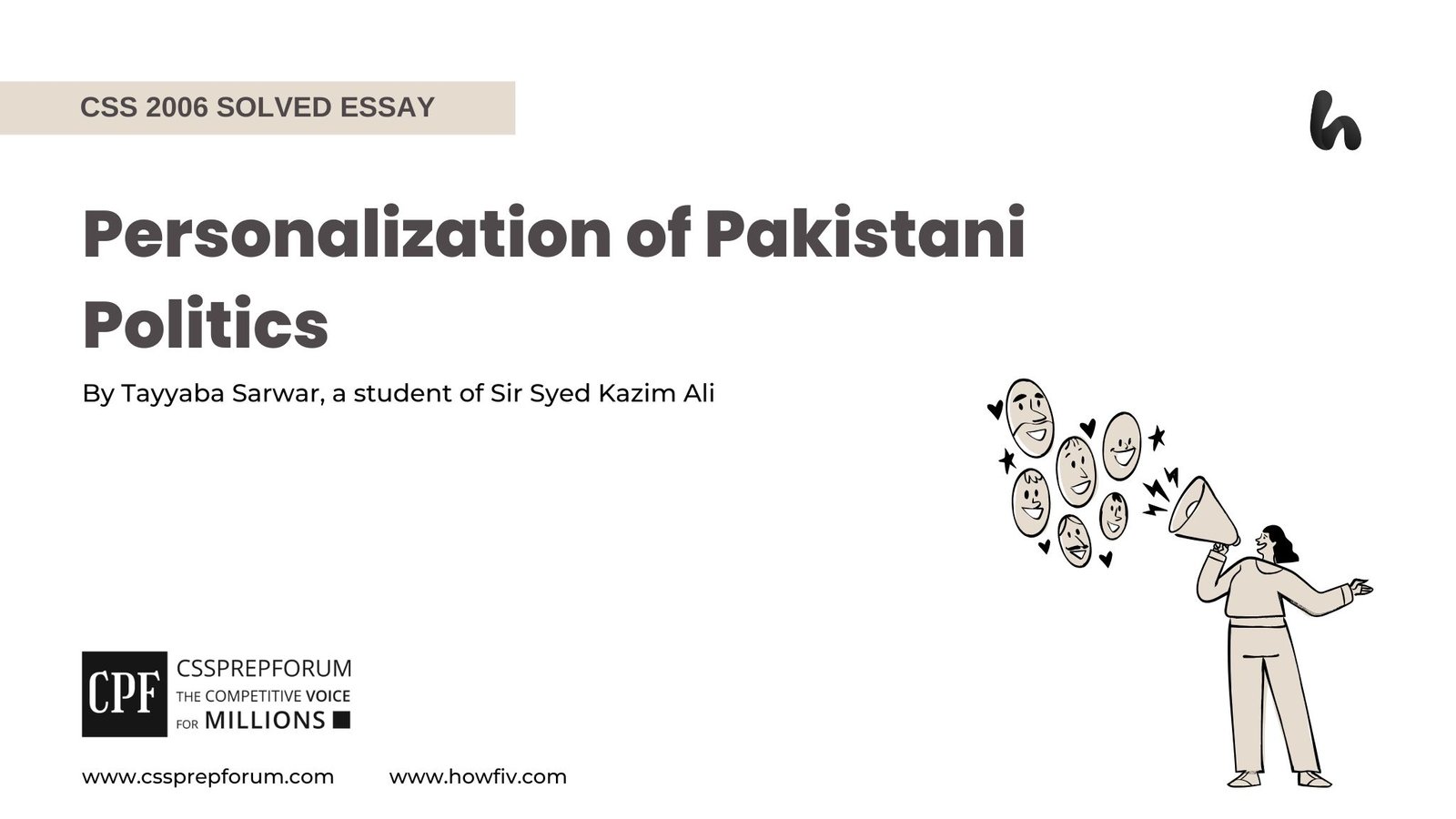CSS Solved Political Science 2022 Past Paper | The Development of Local Self-Government in Pakistan
The following question is attempted by Miss Dr. Shumaila Parveen, the top scorer in CSS Political Science papers. Moreover, the answer is written on the same pattern, taught by Sir to his students, scoring the highest marks in compulsory subjects for years. This solved past paper question is uploaded to help aspirants understand how to crack a topic or question, how to write relevantly, what coherence is, and how to include and connect ideas, opinions, and suggestions to score the maximum.

Question breakdown
The examiner has asked to discuss in detail the development of local self-government in Pakistan. Thus, initiating the interrogation with a concise starter and knowing the meaning of local self-government and its status is pertinent for a better answer. Moreover, the question demands a critical analysis and an ending statement.
Outline
1-Introduction
Many experiments have been done to establish a desired democratic local self-government in Pakistan, yet the devolution of power, resources, and revenue to the local levels is a distant dream as the provinces’ governments have meagerly energized the local governments, the politics of patronization is on the run, and bureaucratic doldrums are colossal.
2-Deciphering the concept of “Local self-government”
3-Importance of local self-government
4-The development of the local self-government in Pakistan
- ✓Basic democratic order of Ayub Khan
- ✓Local self-government structure under the Presidency of Zulfiqar Ali Bhutto
- ✓Local Government order of Zia-ul-Haqq
- ✓ Musharraf’s Local Government Order
- ✓Local government structure of 2008
- ✓Policy of decentralization during Imran Khan Regime
- ✓The present form of the Local self-government
5-Critical Analysis
6-Conclusion

Answer to the question
1-Introduction
Decentralizing authority and power to the local level is vital to an effective democratic administration. Akin to global democracies with particular forms of administrative self-government, the self-local government of Pakistan follows certain patterns. However, since the country’s inception, little focus has been given to the administrative structure of Pakistan. The administrative functions’ bureaucratic and military interventions were substantial in this regard. Additionally, the country has failed to hold elections within approximately the first twenty (20) years during its natal period. Further, the limited franchise options in the elections of 1965, the Board of Director (BD) local government order, the Local Government Ordinance of 1977 of the military ruler, Zia-ul-Haqq, and the Local Government Order (LGO) of 2001 highly centralized the power and authority of the state. Unfortunately, these local self-government models caused the domination of the civil and military bureaucracy over the country. Moreover, despite introducing the 18th Amendment in the constitution of Pakistan, the local governments of the provinces have meagerly energized the local governments, and the hope for the devaluation of power, resources, and authority is still waiting in line with patience.
2-Deciphering the concept of Local Self-government
Explaining the concept, local self-government is a legally authoritative organization. Here, public representatives take public office for a limited period and inherent resources, power, and authority from the upper cadre of government to run the administrative functions of villages, towns, and districts. Moreover, the locally elected people are politically affiliated, represent a certain society or group of people, and run the state’s machinery in the favor of the public. Pakistan, being a federal republic, has three tiers of government: national, provincial, and local. Furthermore, even though each province has its own local government legislative model to execute the administrative functions through locally elected representatives, ministers, and bureaucracy, the central administration is the heart of the local government, the central unit of control.
3-Importance of Local Self-government
Generally, local self-government is traditionally used as local government. It has two vital purposes: decentralizing power and resources and empowering local people at the grassroots level. Decentralization broadly means facilitating administration and devolving functions and authority from the federal government to local administrators. Moreover, two basic functions of local self-government are administrative and municipal services. It offers, manages, implements, preserves, and advances municipal infrastructure and service delivery. It runs real estate, manages property and assets, levies taxes, enforces municipal law, and regulates municipal services. In addition, local self-government levies taxes and fees to generate income and operate local markets, parks, health care centres, sanitation services, and resource delivery. Local self-government is thought to be the nursery of future leadership and diplomats, and it also possesses the primary role of managing local affairs candidly, swiftly, and within budget. Additionally, the local government structure connects locals to the upper administration. As a result, people feel more connected and satisfied with their government.
4-The development of the Local Self-government in Pakistan
Regarding its development in Pakistan, the country has inherited a flawed local government system from the British colonial government. Feudalism, initially introduced by Lord Cornwallis in 1870, later became the permanent seat in the local government of Pakistan. Thus, an insincere portfolio of government develops the rural elite class that only serves their interests. Additionally, Pakistan is a federal parliamentary state with a three-tier governance structure. In urban areas, Pakistan has innated the same local government structure as the English colonialism. To conclude, after birth, in the rural areas of Pakistan, local councils were formed, mainly comprised of feudal lords for the local administration, and urban councils were formed in the cities, which provide municipal and administrative services in the metropolitan areas. Pakistan also passed numerous acts in 1947, 50, 53, and 54 to strengthen the local government structure; however, the military intrusion in 1958 falsified all these acts, and 1959 gave local self-government to the country.
- ✓Basic democratic order of Ayub Khan
First, the military dictator Ayub Khan introduced Pakistan’s first extensive local government system in 1958. The Basic Democracies Ordinance 1959 of General Ayub Khan customized the new local governments that dissolved the higher tiers of elected administration in 1959. He revived the local governments as the only representative tier of the government. The fundamental structure of the Basic Democratic Ordinance consisted of four levels, from higher tier to lower tiers, division councils, district councils, tehsil councils, and union councils or town committees. The prime objectives of the Basic Democratic Ordinance were to direct the centre, nurture pro-military management at the local level, and legitimize the presidential constitution in 1962. Overall, the local government structure of the 1960s was the carbon copy of colonial government, where the bureaucracy regulated local administration and municipal functions. Moreover, Deputy Commissioners and Commissioners chief bureaucrats were functional at the district and the division levels, respectively, and they had the authority to regulate and annul any administrative proceedings or decisions taken by the local councils.
- ✓Local self-government structure under the Presidency of Zulfiqar Ali Bhutto
Next, the Ayub’s Basic Democratic Ordinance operated for over ten years. Afterwards, a brief democratic term was formed by Zulfiqar Ali Bhutto. Although his cabinet gave a local government order known as the People’s Local Government, aimed at devolving power to the local representatives, giving rights to women and minorities, and effectively curtailing the military intervention in politics and public affairs, his government followed the Basic Democratic Ordinance of Ayub Khan’s administration as the then cabinet’s local government proposal was not given a chance to implement. Moreover, despite adopting nationalist measures in the local administration, the local government of Pakistan in the Bhutto regime was flooded with feudal lords, further marring the concept of an honest democratic local self-government.
- ✓Local self-government structure in the regime of Zia Ul Haqq
Additionally, after a brief democratic phase under Zulfiqar Ali Bhutto (1972-77), once again, the armed forces legalized the control of General Zia-ul-Haq’s military coup in 1977 over the state. Nonetheless, a high treason case has been legislated for any future coup d’etat. Unfortunately, the government of Pakistan’s first elected prime minister was toppled, and a new local government system was reformed for each province, federal area, tribal area, and northern area. Each provincial government of Pakistan was primarily divided into two main categories: urban councils and rural councils. Each urban council was divided into town committees, municipal committees, municipal corporations, and metropolitan corporations to manage and perform the local administration. Likewise, each rural council was subdivided into district councils that supervised union councils. In addition, the elections were held non-party in all the provinces, the elected bodies were given no constitutional protection, and little financial power was bestowed on these representatives. Consequently, the Local Government Order of Zia-ul-Haq was highly centralized with the absence of national and provincial assemblies, holding the 1973 Constitution, which was introduced by late Prime Minister Zulfiqar Ali Bhutto, in abeyance. The Local Government Ordinance 1979 remained operational until 2000 in Pakistan.
- ✓General Musharraf regime’s Local Government System
Another military dominance in the country was promulgated in 1999. General Musharraf took office as president in 2001 and introduced a new local government system, the Local Government Ordinance (LGO) 2001. His LGO had several distinctions that substantially restructured the local government of Pakistan. LGO prevailed over the urban-rural partition and introduced the local management at three levels: Union Council, Tehsil Council, and District Council. The union was the central unit while tehsil and district councils were the upper tiers of the local government. Further, the Union Nazims (mayor) and Naib Nazims (deputy mayor) were directly elected, as were the elected members of the District and Tehsil Councils, respectively. This system detached the previously existing hierarchical connection between the local and provincial governments; instead, it directly linked the President’s office to the provincial administrative government through the National Reconstruction Bureau and the Devolution Trust for Community Empowerment. Moreover, unlike the subsequent local government systems, Musharraf decentralized administrative, financial, and development powers to the elected officials in the local councils. To counter-check these departments, all the government departments became accountable to the District Council. The scheme, for the first time in the history of Pakistan, introduced the Provincial Finance Commission, an institutional framework to allocate resources between provinces and their subsequent local governments. LGO also empowered the women and allocated them 33 per cent of the National Assembly seats. Further, to strengthen the local government, Musharraf introduced District Monitoring Committees to monitor the work of government departments, Citizens Community Boards (CCB), and Citizen Police Liaison Committees (CPLC), enhancing the rule of law, protecting civil rights, and empowering the citizens to increase social and political activism.
- ✓Local government structure of 2008
Further, the LGO system of Musharraf remained intact till 2008; the dismissal of the military ruler from the presidential office provided a suitable ground for a democratic local government. All the political parties jointly proposed and passed the 18thAmendment in the constitution of Pakistan, curtailed the residuary power of the federal government, reduced the authority of the President, gave more rights to the provincials’ governments, and, at the same time, protected the fundamental rights of the masses. Moreover, by 2009, the constitutional prohibition on amending the local government had expired, making it possible for the provinces to legislate their local governments. Nevertheless, despite having fortunate ground on a plate, the provincial governments have not shown the same enthusiasm to formulate and implement local governments. In 2010, Baluchistan passed the Local Government Act, while the provincial assemblies of Punjab, Khyber Pakhtunkhwa (KPK), and Sindh introduced the Local Government Act in 2013. The government of KPK readopted the LGO of Musharraf’s regime whereas the governments of the remaining provinces implemented the Local government ordinance of Zia ul Haq. Although these governments were run by the local representatives and the provinces were to legislate, little fiscal and revenue power and authority were devolved to the local representative at the union level. It is because the provincial ministries and the member of the provincial assemblies, owing to their private agendas, were reluctant to decentralize resources and power to the local levels.
- ✓The policy of decentralization during Imran Khan Regime
Moreover, the 2018 elections gave the government powers to Imran Khan and his political party. After assuming authority, his cabinet nullified the preexisting local government structure in Punjab and KPK while the Local governments of Baluchistan and Sindh retained their already prevailing local self-government structure. Khan reintroduced the rural-urban peculiarity, formulated the Local Government Act 2019 in Punjab, established Metropolitan, Municipal, Town Corporations, and Town Committees in urban areas, and instituted Tehsil Councils for rural areas of the country. The regime of Khan could be elaborated dichotomously. First, the empowerment of the local government attained some momentum, but the paramount role of the non-political institutions and the personal agendas of provincial ministries throughout the country did not allow the country to enjoy democracy and attain a desire for local self-government.
- ✓The present form of the Local self-government
Presently, under the collation government, each province has certain autonomy. Each urban area has metropolitan corporations, and each rural area contains district councils, the highest tiers of their local government. Moreover, the governments of each province, except the government of KPK, where Tehsil and village councils operate in urban and rural areas, respectively, have two or three tiers in all provinces. Further, each district council and metropolitan corporation are under the command of District Coordination Officers (DCO), while Tehsil councils and Tehsil Municipals are regulated by Tehsil Municipal Officers (TMO). The government is far from the desired form to measure the strength of the local self-government of Pakistan. The local representatives enjoy meagre authority and monetary benefits. Additionally, the provincial ministries, DCOs, and TMOs are very reluctant to allow the decentralization of power and resources. The departments of revenue generation, fiscal management, and police are highly centralized in their work and management. Similarly, the feudal system, particularly in South Punjab and Sindh, reduces the capacity of the local self-government. The overbearing politics of a few families, the personalization of the members of the National Assembly, colossal corruption, and, last but not least, the uncontrolled military interventions in the local government and the federal government make it impossible for the country to properly establish a people-centred local self-government.
5-Critical Analysis
To evaluate the local government system of Pakistan, it could be easily understood that, throughout its history, the country has failed to adopt any democratic form of local self-government. The initial Basic Democratic Ordinance was a purely military strategy to control the state’s administrative affairs. Later, the non-implementation of Bhutto’s local government scheme and the eventual implementation of Zia’s Local Government Ordinance 1979 did not allow the country to nurture democratic values. Ultimately, a culture of patronage, nepotism, and favouritism has been introduced, halting the devolution of resources and authority and the growth of leadership. Additionally, the successive military dictatorship, political interventions, and the curse of feudalism have minimized the legitimacy of local self-government and weakened the local government structure from its core.
6-Conclusion
To sum up, the history of the local self-government of Pakistan has shown a constant struggle of the country to establish a desired administration. To elaborate, the Basic Democratic Order of 1959 did not favour the local representatives, Zulfikar Ali Bhutto’s democratic era strengthened the feudal political culture, and Zia ul Haq’s concept of the local self-government not only illegalized the political parties but also implemented a centralized form of local government. Additionally, the Local Government Ordinance of 2001 further strengthened the military and bureaucratic roles in the local government of Pakistan. The new democratic era of 2009 introduced the 18th Amendment to the constitution, and it has been deemed an optimistic opportunity to strengthen the local government. Nonetheless, the federal and provincial governments have fallen short of devolving revenue, resources, and authority to the local levels, while the culture of despotism, nepotism, and favouritism has attained more grounds. Consequently, all the Local governments of Pakistan have not made the grade towards a beneficial local administration, and the country is keenly waiting for a national, democratic, self-local government to implement it.

CSS Solved Past Papers’ Essays
Looking for the last ten years of CSS and PMS Solved Essays and want to know how Sir Kazim’s students write and score the highest marks in the essays’ papers? Then, click on the CSS Solved Essays to start reading them.
CSS Solved Essays

CSS Solved General Science & Ability Past Papers
Want to read the last ten years’ General Science & Ability Solved Past Papers to learn how to attempt them and to score high? Let’s click on the link below to read them all freely. All past papers have been solved by Miss Iqra Ali & Dr Nishat Baloch, Pakistan’s top CSS GSA coach having the highest score of their students.
General Science & Ability Solved Past Papers
CSS Solved Pakistan Affairs Past Papers
Want to read CSS Pakistan Affairs Solved Past Papers and learn how to attempt them to score high? Let’s click on the link below to read them all freely. All past papers’ questions have been attempted by Sir Kazim’s students, who scored the highest in the subject.
CSS Solved Pakistan Affairs
CSS Solved International Relations’ Past Papers
Have you opted for International Relations in the CSS examination and want to score above 150? Then, click on the CSS Solved International Relations’ Past Papers by Miss Abeera Fatima, the top IR scorer and the best IR coach in Pakistan.
CSS Solved International Relations Past Papers












